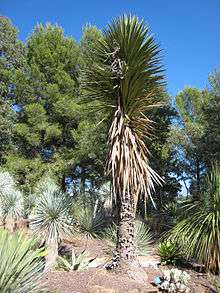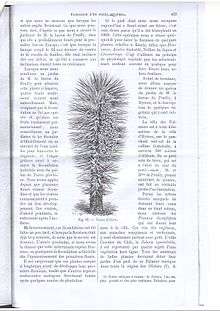Yucca filifera
| Yucca filifera | |
|---|---|
 | |
| Scientific classification | |
| Kingdom: | Plantae |
| Division: | Angiosperms |
| Class: | Monocots |
| Order: | Asparagales |
| Family: | Asparagaceae |
| Genus: | Yucca |
| Species: | Y. filifera |
| Binomial name | |
| Yucca filifera Chabaud | |
| Synonyms[1] | |
| |
Yucca filifera is a member of the Asparagaceae family subfamily Agavaceae native to central Mexico.
History
It was discovered in 1840 in northeastern Mexico between Saltillo and Parras (23°37′0″N 102°34′30″W / 23.61667°N 102.57500°W) on 19 May 1847 by merchant and explorer Josiah Gregg.[1] It was later introduced to Europe and described for science by J. Benjamin Chabaud (1833-1915) in 1876.[1]
Description

A tall, heavily branched yucca, Y. filifera has straight, ensiform leaves growing in rosette-shaped bunches from the end of each stem.[2] Its inflorescence hangs over and is made of many separate white flowers.[2]
Cultivation
Y. filifera can be cultivated in xerophytic conditions. It is used as roof covering and as a source of fibre for handcrafting by the indigenous people, who call it Palma China or Izote.[3]
| Wikispecies has information related to: Yucca filifera |
| Wikimedia Commons has media related to Yucca filifera. |
References
- 1 2 3 Yucca filifera Chabaud, Tropicos, Missouri Botanical Garden, 2013
- 1 2 R.J. Hodgkiss, The Yucca Page, 20 February 2012, accessed 25 March 2013
- ↑ Palma china, Izote, Palma corriente, Palma grande - Yucca filifera, InfoJardin, Jardineros Paisajismo Plantas, 2013, accessed 25 March 2013
See also
- Zdeněk Ježek; Libor Kunte (July 2007). Encyclopedia of Succulents. Bookmart Limited. ISBN 978-90-366-1705-5. Retrieved 25 March 2013.